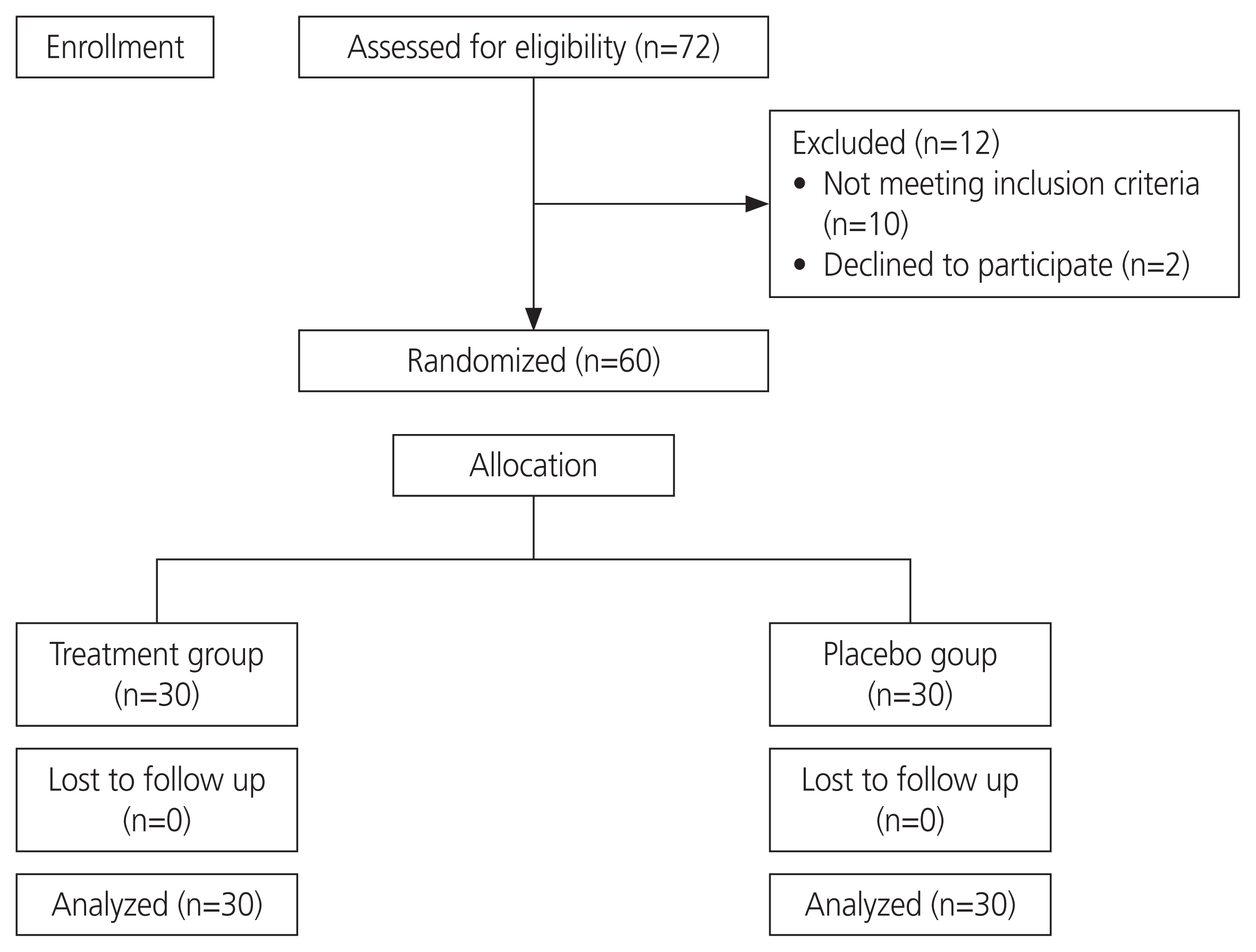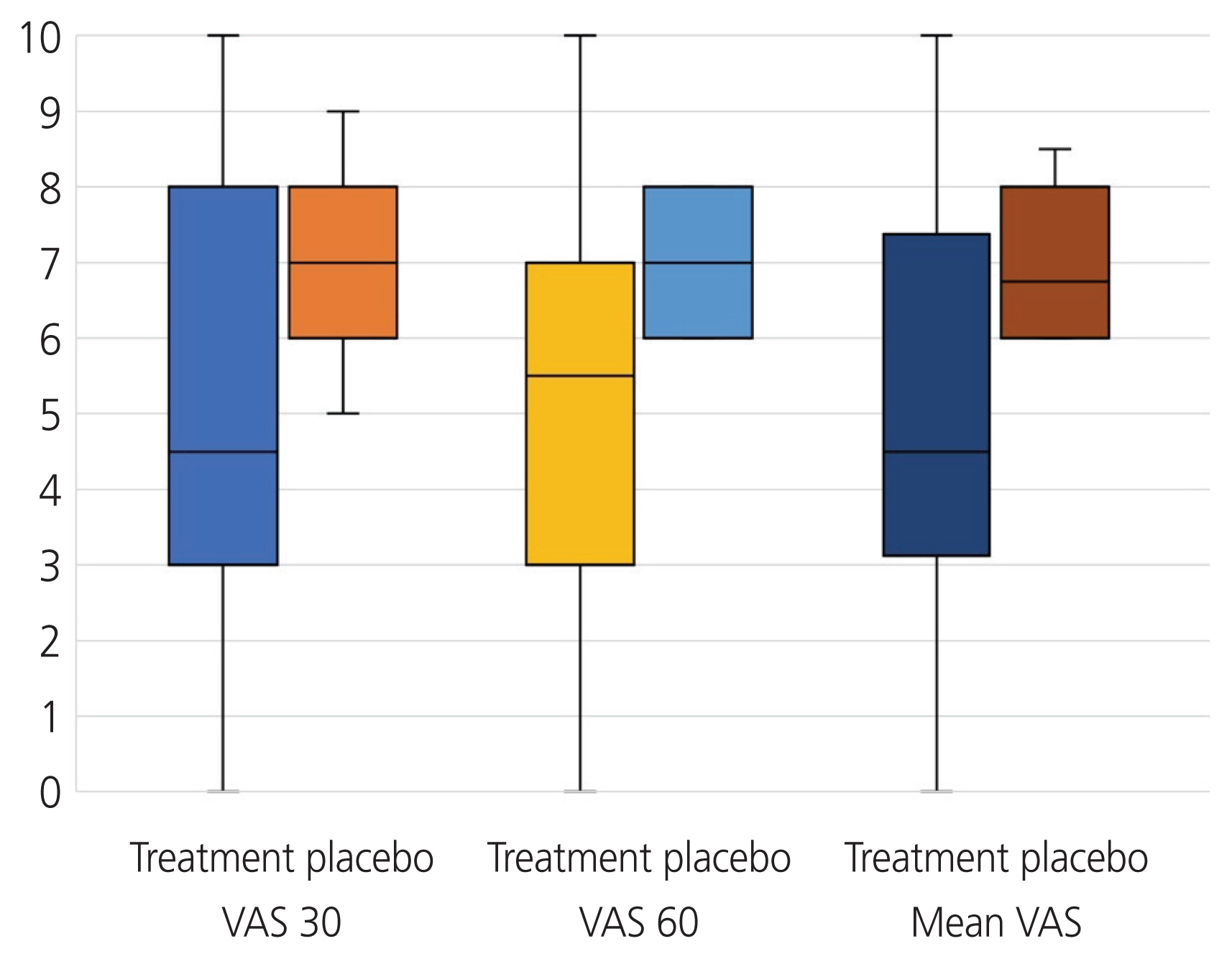Role of para-cervical block in reducing immediate postoperative pain after total laparoscopic hysterectomy: a prospective randomized placebo-controlled trial
- Affiliations
-
- 1Minimally Invasive Unit, Department of Obstetrics and Gynecology, All India Institute of Medical Sciences, New Delhi, India
- KMID: 2511573
- DOI: http://doi.org/10.5468/ogs.20271
Abstract
Objective
To study the efficacy and safety of 0.5% bupivacaine in paracervical block to reduce immediate postoperative pain after total laparoscopic hysterectomy.
Methods
A prospective, randomized, double-blind, placebo-controlled study was conducted at a tertiary referral center involving thirty women each in the treatment and placebo groups. Paracervical block with 10 mL of 0.5% bupivacaine (treatment group) or 0.9% saline (placebo group) was administered following general anesthesia and prior to proceeding with total laparoscopic hysterectomy. Visual analogue scale (VAS) scores at 30 and 60 minutes post extubation and mean VAS score (average VAS score at 30 and 60 minutes) were compared. Adequate pain control was defined as mean VAS score ≤5. Additional postoperative opioid requirement, hospital stay, and readmissions were also compared.
Results
Baseline variables such as age, previous history of cesarean section, operating time, and weight of the specimen were comparable in both groups. VAS scores at 30 (5.0±2.8 vs. 7.0±1.4) and 60 minutes (5.2±2.8 vs. 7.0±0.8) and the mean VAS score (5.1±2.7 vs. 6.8±0.9) were significantly lower in the treatment group. Adequate pain control (mean VAS score ≤5) was 57% higher and additional opioid consumption was 47% lower in the treatment group. No significant difference was found in the duration of hospital stay and readmission rate.
Conclusion
Paracervical block with bupivacaine was useful in reducing immediate postoperative pain with a 25% reduction in mean VAS score and a 47% reduction in opioid consumption in the first hour after total laparoscopic hysterectomy.
Keyword
Figure
Cited by 2 articles
-
Preemptive pregabalin for postoperative analgesia during minimally invasive hysterectomy: a systematic review and meta-analysis of randomized controlled trials
Ahmed Abu-Zaid, Osama Alomar, Nora F AlNaim, Fatimah Shakir Abualsaud, Mohammed Ziad Jamjoom, Latifa F AlNaim, Abdullah AMA Almubarki, Saeed Baradwan, Saud Abdullah Saud Aboudi, Faisal Khalid Idris, Meshael Fodaneel, Ismail A Al-Badawi, Hany Salem
Obstet Gynecol Sci. 2022;65(2):133-144. doi: 10.5468/ogs.21345.A novel radiofrequency modulation therapy versus routine physiotherapy modalities in treatment of myofascial pelvic pain syndrome: a pilot randomized trial
Elaheh Miri Ashtiani, Nasim Shokouhi, Mona Mohseni, Nafiseh Saedi, Ali Asghar Haeri-Mehrizi, Mahmood Bakhtiyari
Obstet Gynecol Sci. 2023;66(3):230-240. doi: 10.5468/ogs.22171.
Reference
-
References
1. Krishnakumar S, Tambe P. Entry complications in laparoscopic surgery. J Gynecol Endosc Surg. 2009; 1:4–11.
Article2. Choi JB, Kang K, Song MK, Seok S, Kim YH, Kim JE. Pain characteristics after total laparoscopic hysterectomy. Int J Med Sci. 2016; 13:562–8.
Article3. Bisgaard T, Rosenberg J, Kehlet H. From acute to chronic pain after laparoscopic cholecystectomy: a prospective follow-up analysis. Scand J Gastroenterol. 2005; 40:1358–64.
Article4. Quinn MJ, Kirk N. Differences in uterine innervation at hysterectomy. Am J Obstet Gynecol. 2002; 187:1515–9.
Article5. Kwack JY, Kwon YS. Immediate postoperative pain control with ropivacaine following laparoscopic-assisted vaginal hysterectomy: a randomized double-blind pilot study. Taiwan J Obstet Gynecol. 2018; 57:654–8.
Article6. Radtke S, Boren T, Depasquale S. Paracervical block as a strategy to reduce postoperative pain after laparoscopic hysterectomy: a randomized controlled trial. J Minim Invasive Gynecol. 2019; 26:1164–8.
Article7. Acton JN, Salfinger SG, Tan J, Cohen PA. Outcomes of total laparoscopic hysterectomy using a 5-mm versus 10-mm laparoscope: a randomized control trial. J Minim Invasive Gynecol. 2016; 23:101–6.
Article8. Bacal V, Rana U, McIsaac DI, Chen I. Transversus abdominis plane block for post hysterectomy pain: a systematic review and meta-analysis. J Minim Invasive Gynecol. 2019; 26:40–52.
Article9. Charlton S, Cyna AM, Middleton P, Griffiths JD. Perioperative transversus abdominis plane (TAP) blocks for analgesia after abdominal surgery. Cochrane Database Syst Rev. 2010; CD007705.
Article10. Jain S, Nazir N, Singh S, Sharma S. A prospective randomised controlled study for evaluation of high-volume low-concentration intraperitoneal bupivacaine for post-laparoscopic cholecystectomy analgesia. Indian J Anaesth. 2018; 62:109–14.
Article11. Hollmén A, Korhonen M, Ojala A. Bupivacaine in paracervical block--plasma levels and changes in maternal and foetal acid-base balance. Br J Anaesth. 1969; 41:603–8.12. Kelkar KV. Post-operative pulmonary complications after non-cardiothoracic surgery. Indian J Anaesth. 2015; 59:599–605.
Article13. Jensen MP, Chen C, Brugger AM. Interpretation of visual analog scale ratings and change scores: a reanalysis of two clinical trials of postoperative pain. J Pain. 2003; 4:407–14.
Article14. Barr Grzesh RL, Treszezamsky AD, Fenske SS, Rascoff LG, Moshier EL, Ascher-Walsh C. Use of paracervical block before laparoscopic supracervical hysterectomy. JSLS. 2018; 22:e201800023.
Article15. Long JB, Eiland RJ, Hentz JG, Mergens PA, Magtibay PM, Kho RM, et al. Randomized trial of preemptive local analgesia in vaginal surgery. Int Urogynecol J Pelvic Floor Dysfunct. 2009; 20:5–10.
Article16. O’Neal MG, Beste T, Shackelford DP. Utility of preemptive local analgesia in vaginal hysterectomy. Am J Obstet Gynecol. 2003; 189:1539–41.17. Hristovska AM, Kristensen BB, Rasmussen MA, Rasmussen YH, Elving LB, Nielsen CV, et al. Effect of systematic local infiltration analgesia on postoperative pain in vaginal hysterectomy: a randomized, placebo-controlled trial. Acta Obstet Gynecol Scand. 2014; 93:233–8.
Article
- Full Text Links
- Actions
-
Cited
- CITED
-
- Close
- Share
- Similar articles
-
- Evaluation of the Efficacy of Methylprednisolone, Etoricoxib and a Combination of the Two Substances to Attenuate Postoperative Pain and PONV in Patients Undergoing Laparoscopic Cholecystectomy: A Prospective, Randomized, Placebo-controlled Trial
- Comparison of Postoperative Pain after Abdominal and Laparoscopic Assisted Vaginal Hysterectomy by using IV-PCA
- The Effects of Aroma Essential Oil Inhalation on Stress, Pain, and Sleep Quality in Laparoscopic Cholecystectomy Patients: A Randomized Controlled Trial
- Minimally invasive radical hysterectomy and the importance of avoiding cancer cell spillage for early-stage cervical cancer: a narrative review
- Scheduled injection of ramosetron for prevention of nausea and vomiting following single-port access total laparoscopic hysterectomy: a prospective randomized study



